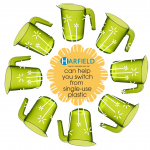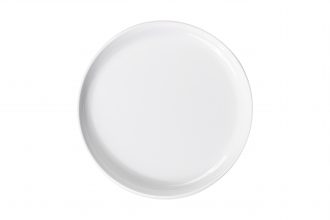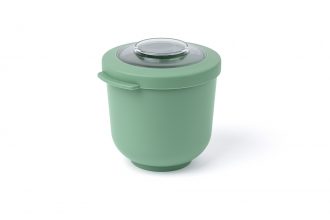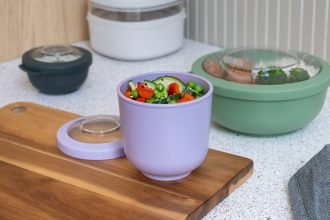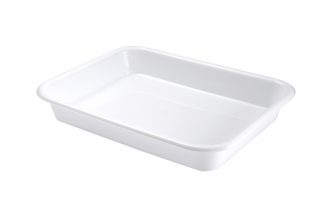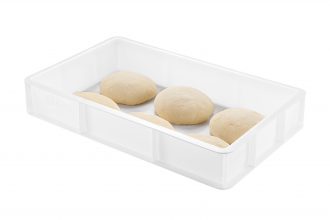The importance of colour
Various studies have shown that we have a great inclination to respond to colour. This means that choosing the right colour schemes, especially in the healthcare sector can be very important. The colour of everyday items such as plates, cups, or jug lids may have a huge effect on the patient, their hydration, nutrition and therefore their wellbeing. Certain colours have been shown to achieve positive results among patients with specific conditions such as dementia, but the impact is always down to each individual.
Blue is one of the most popular colours used in the healthcare sector for many years due to its’ calming effects on patients. It is especially effective in resting and sleeping areas, but also waiting rooms, where patients tend to feel more nervous and anxious. According to ‘The Application of Colour in Healthcare Settings’ released by The Centre for Health Design in 2012, ‘cool colors may be appropriate in environments for agitated, hypertensive, or anxious individuals;’. It is also widely associated with trust and stability. Same as blue, green – the colour symbolizing life, nature and harmony – can be advantageous for patients, who suffer from anxiety or have nervous tendencies as studies show that green colour reduces central nervous system activity.
Other colours showing to be very beneficial in the healthcare sector are red and yellow, which seems to be particularly successful among patients with Dementia and Alzheimer’s. Based on ‘The Application of Colour in Healthcare Settings’, ‘bright, strong colors stimulate and encourage activity’ and further studies show that the colour red can significantly increase brain wave activity. It is also used to stimulate the production of adrenaline in patients, improve the patients’ appetite as well as provide a good visual contrast for the patient. ‘Red and yellows, for example, may be used in settings where creative activity is desired and socialization encouraged; greens and blues in areas that require quiet and extended concentration and high visual acuity (Sharpe, 1974). ‘
Recent trials at different healthcare institutions across the UK have shown positive effects of yellow on patients suffering from Dementia. The first initiative took place back in 2016 on the dementia ward at Furness General Hospital, in Barrow, where patients were served an additional 10 grams of food to their usual portions and the meals were plated on brightly coloured plates rather than plain alternatives. Dianne Smith, the matron for dementia at the University Hospitals of Morecambe Bay NHS Foundation Trust, mentioned speaking to the Daily Mail: ‘People with dementia often experience visual problems, including not being able to distinguish between different colours’, but highly contrasting colours such as yellow on a white table provided great help to navigate between different objects – ‘If the crockery is a similar colour to the food being served then a person with dementia may not be able to see the contrast and recognise the food that is there to be eaten. The use of colour in crockery also helps stimulate interest in patients with dementia, enhances food presentation but it also encourages appetite.’
The trial showed that using vibrant yellow plates to serve meals to patients encouraged them to finish their meals. As a lot of patients suffering from Dementia are elderly and frail, using bright tableware during meal times helped with healthy weight gain and boosted nutrition among patients.
A different trial took place last year at the University of South Wales, where six trainee nurses developed a scheme to help identify patients, who are at a higher risk of dehydration and require extra supervision of fluid intake. They have trialled using yellow jug lids instead of the traditional blue ones for patients’ bedside water jugs. The nurses have found yellow to be a strong colour to aid visually impaired patients as well as attract the attention of patients that suffered from dementia. It also helped the nurses and health care support workers easily identify the patients, who required extra fluid intake monitoring to keep hydrated.
In May 2018 the BBC published an article on the trial of yellow jug lids in a few healthcare institutions (read more here: https://www.bbc.co.uk/news/uk-wales-south-east-wales-44003761) mentioning that “The lids, which can cost as little as 70p each, could also be much cheaper than the cost of treating urinary tract infections or catheterisation, which it has been estimated costs the NHS £500m a year.” Studies show that yellow colour can trigger memory as well as cognitive functions, which is why it is a colour popularly chosen for people with dementia.
As research on colours and their effect on us is advancing, we are gaining more information on how to utilize different hues to benefit patients. Some studies have recommended the use of pink colour for patients, who can have aggressive tendencies. Utilizing pink objects such as plates, cups, jugs etc in their everyday surroundings, may ease those tendencies and calm the patient.
Even though we are not able to strictly associate one colour with a particular condition, there seems to be plenty of evidence that shows us positive effects of use of colour in the healthcare sector. Not only, it can improve the wellbeing of the patient, but also help nurses tend to patients more efficiently at often extremely busy wards or even prevent high costs of treating conditions and infections developed due to dehydration, malnutrition, etc.
Here, at Harfield, we stock a vast range of products specifically designed with the healthcare sector in mind. With just short of 60 years of experience supplying hospitals, nursing and care homes as well as many other establishments in the sector, we have developed a great assortment of colours for our tableware. The different colours can be used to aid colour coding for specific areas, special diets, the partially sighted or conditions such as dementia. Our tableware is also safe to use, lightweight and extremely durable. Please feel free to contact us at carolmoodie@harfieldtableware.co.uk or on 0161 477 5678 to find out how we can help you through the purchasing process by recommending products that best suit your needs.



